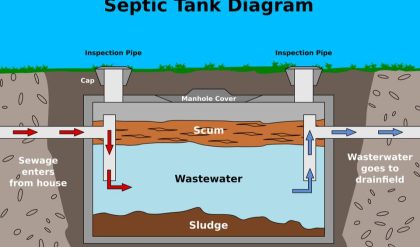When you throw away half-eaten food or a broken item, do you ever think about what happens next? For most people, once an item goes in the trashcan, it is no longer thought of, but for the item, the journey continues.
Historically, trash was removed from the home or business and placed in large open-air piles. This method resulted in harsh odors, contamination, and infestations by rodents and insects.
In 1935, a new system of waste disposal, called sanitary landfills, was created in Fresno, California. Currently, over 55% of all municipal solid waste that is created in the United States is disposed of in sanitary landfills. Sanitary landfills are a method of waste disposal where the waste is buried either underground or in large piles. This method of waste disposal is controlled and monitored very closely.
For sanitary landfills, the process starts by digging a large hole in the ground that is then lined with thick plastic (normally 2-4 feet thick) and a layer of impervious clay. The bottom of the landfill is also lined with a network of plumbing that functions as a collection system for any liquids. Leachates is the term used to describe liquids that leach or leak from the landfill, and this system collects the leachates. These components of the sanitary landfill help prevent materials and liquids from spreading to the surrounding ground and waterways.
Once the landfill is set up, waste can then be added to the landfill. Instead of simply filling the landfill completely with waste, the landfill is organized in layers. The layers alternate between waste and soil. This alternation of materials reduces odors and allows for more rapid decomposition, which is the breakdown of materials. When a landfill is full, it is sealed and covered in a thick layer of clay. Once the landfill has been evaluated and considered safe, it can be converted into a park or open space for human use. It is interesting to think that a location where we put our unwanted materials can then be turned into a location for recreation and fun.
Issues With Sanitary Landfills
When you compare sanitary landfills to the previous waste disposal method of open-air piles, the landfills are clearly a step in the right direction. Although sanitary landfills are an improvement over previous methods, there are still many issues and concerns associated with this method of waste disposal.
The largest issue associated with sanitary landfills is the risk of pollution. As waste breaks down, methane gas is created, and if it escapes from the landfill, it could pollute the air. In addition, methane gas can be dangerous if it builds up in the landfill because it is flammable and could be explosive. Along with air pollution, sanitary landfills also pose a threat to water systems. If the lining of the landfill is punctured or the collection system breaks, leachates could travel from the landfill to the surrounding ground and contaminate the groundwater.
Another issue with sanitary landfills is their location. Would you want a huge hole in the ground full of trash in your neighborhood? Of course not, and most people would agree with you. Due to the fact that most sanitary landfills are unsightly and potentially smelly, they are placed far away from cities and residential areas. Although the distant location of landfills is desirable to people, it causes several problems associated with transporting the waste. The increased transportation results in more air pollution from gas consumption and noise pollution from trucks.
There is also concern that, due to the design of sanitary landfills, the rate of decomposition will be slow and potentially incomplete. This could lead to the need for more landfills over time and potentially revisiting landfills that do not decompose completely. In addition to these concerns, people are also worried that landfills may not be safe because, as the waste decomposes or settles, the land could shift, causing unstable ground.



